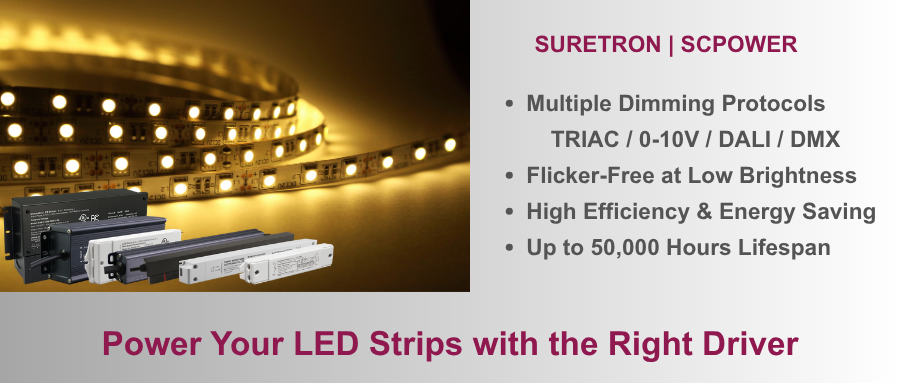In the procurement process of LED strip lights, a common oversight among buyers is prioritizing the strips themselves while neglecting the selection of LED drivers. However, the LED driver serves as a core component in LED strip lighting projects—it not only determines whether the strips can operate normally but also directly impacts critical performance indicators such as brightness stability, color temperature consistency, and the overall service life of the strips. Improper driver selection may lead to issues including light flickering, uneven brightness, reduced lifespan, or even irreversible damage to the strips. This article outlines key considerations for selecting the right LED driver for LED strip applications.
Rationale for Equipping LED Strips with Dedicated Drivers
Most low-voltage LED strips cannot be directly connected to alternating current (AC) mains power (typically 220V). The primary function of an LED driver is to convert 220V AC into stable direct current (DC)—a prerequisite for the safe and reliable operation of LEDs. Without a properly matched driver, the strips risk overheating, burnout, or stroboscopic effects. For instance, professional manufacturers like Suretron have developed constant-voltage driver series tailored to LED strip applications, ensuring long-term operational stability through optimized voltage regulation.
Selection of Constant-Voltage vs. Constant-Current Drivers
LED drivers are classified into two main types: constant-voltage and constant-current, with distinct application scopes:
Constant-voltage drivers: Common output voltages are 12V DC and 24V DC. The vast majority of commercial and industrial LED strips are designed for constant-voltage operation, making this driver type the standard choice for strip lighting projects.
Constant-current drivers: Primarily intended for single LED diodes or small LED modules. Due to the inherent current stability requirements of LED strips, constant-current drivers are rarely used in strip-specific applications.
A critical first step in selection is verifying the driver type (constant-voltage/constant-current) specified on the LED strip’s technical datasheet. Mismatch between driver type and strip requirements will result in complete operational failure. For example, Suretron’s constant-voltage driver portfolio covers a power range of 10W to 800W, ensuring compatibility with most 12V/24V LED strips available in the market and simplifying the selection process for project buyers.
Voltage and Power Matching Criteria
Voltage compatibility is non-negotiable: a 12V LED strip must be paired with a 12V constant-voltage driver, while a 24V strip requires a 24V driver.
Power matching is equally critical. In practical projects, insufficient driver power can cause flickering, while overloading may trigger protective shutdowns or damage components. To address this, Suretron provides customized power calculation services and selection guidance for clients, ensuring the driver’s rated power aligns with the total power consumption of the connected LED strips (accounting for a 10–20% safety margin to accommodate peak loads).
Considerations for Dimming Functionality
If the project requires brightness adjustment or ambient lighting control, a dimmable driver is necessary. The choice of dimming protocol depends on the project’s control needs:
Wired dimming: Protocols such as DALI-2, TRIAC, and 0–10V are widely used in commercial spaces (e.g., offices, retail stores) where stable, low-latency control is required.
Wireless smart control: Technologies including Zigbee, Bluetooth, and Wi-Fi are suitable for residential or flexible-layout projects, enabling remote control via mobile devices.
Suretron offers driver solutions compatible with both wired and wireless dimming protocols, supporting designers and purchasers in adapting to diverse project requirements.
Environmental Adaptation: Indoor vs. Outdoor Applications
The driver’s environmental protection rating must match the installation scenario:
Indoor dry environments (e.g., living rooms, bedrooms): Standard non-waterproof drivers (no IP rating requirement) are sufficient.
Outdoor or humid environments (e.g., landscape lighting, building facades): Drivers with a minimum IP65 or IP67 rating are mandatory to prevent water ingress and corrosion.
Suretron’s outdoor waterproof driver series features an IP67 protection rating, specifically engineered for landscape LED strips and exterior lighting projects, ensuring durability under harsh weather conditions.
Criteria for Evaluating Driver Reliability
Beyond technical parameters, the following factors determine driver reliability:
Certifications: Compliance with international standards (UL, CE, ENEC, FCC, SAA, CB) is essential. Uncertified drivers may fail project acceptance and pose safety risks. Certifications also facilitate market access in regions such as North America, Europe, and Oceania.
Service life: High-quality drivers typically offer a service life of 50,000 hours or more, aligning with the lifespan of LED strips (50,000–100,000 hours) to avoid premature replacement.
Protective functions: Built-in safeguards (overvoltage protection, short-circuit protection, overtemperature protection) mitigate risks of component damage caused by electrical anomalies.
Supplier capabilities: Reliable after-sales support and technical assistance (e.g., on-site troubleshooting, customization) are critical for project success.
Conclusion
A properly selected LED driver is not only a "power guarantee" for LED strip operation but also a key enabler of project quality—enhancing lighting performance and extending the system’s service life. By choosing a reputable supplier like Suretron, which combines high-quality products with comprehensive technical support, buyers can meet the core requirements of safety, stability, and longevity for diverse lighting projects.

Frequently Asked Questions
Q1: What are the most critical parameters when selecting a power supply for an LED light strip?
A1: The most critical factors are power matching and output type. The driver power should be slightly higher than the total power of the light strip, and the output type must match the light strip type (constant voltage or constant current) to ensure stable brightness and longevity.
Q2: What are the effects of insufficient or excessive driver power?
A2: Insufficient power can result in insufficient brightness or driver overload, shortening the lifespan. Excessive power, while safe, increases cost and size. It is generally recommended to select a driver that is 10%-20% higher than the total power of the light strip.
Q3: What is the relationship between the lifespan of the LED driver and the lifespan of the light strip?
A3: Driver lifespan directly affects the stable operation of the light strip. A high-quality driver can maintain a constant current/voltage output, reducing voltage fluctuations and temperature rise, thereby extending the lifespan of the light strip.












